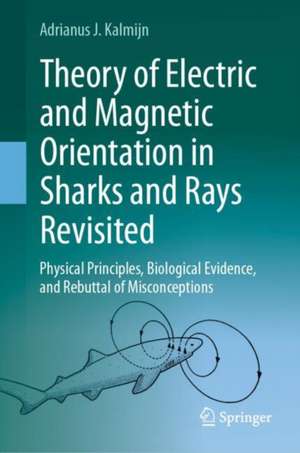Theory of Electric and Magnetic Orientation in Sharks and Rays Revisited: Physical Principles, Biological Evidence, and Rebuttal of Misconceptions
Autor Adrianus J. Kalmijnen Limba Engleză Hardback – 29 aug 2024
The physics of the entire sensory environment interacting with these very sensitive organs is made clear step by step so the reader can understand the source of the fields and how the animals detect them. Dr. Kalmijn analyzes the sensory organs from the perspective of the animal moving through these electric and magnetic fields to arrive at the appropriate relativistic frame to understand how the sensory system works. Relying on his thorough understanding of Maxwell, Faraday, and Einstein, he has sought to understand the miraculous abilities of Elasmobranchs.
The detailed presentation clears away many of the misunderstandings and mistakes of previous researchers. Nearly all the mistakes pertain to the underlying physics. The existing literature is discussed, put in context, and corrected.
This summary and final presentation of Dr. Kalmijn’s life-time study of electromagnetic reception in Elasmobranchs will surely be recognized as the definitive treatise in years to come. It gives researchers and students in biology, physics, oceanography, and fisheries a detailed mathematical physics background for the understanding of electroreception in Elasmobranch fishes.
Preț: 888.22 lei
Preț vechi: 1083.19 lei
-18% Nou
Puncte Express: 1332
Preț estimativ în valută:
169.96€ • 185.20$ • 143.22£
169.96€ • 185.20$ • 143.22£
Carte disponibilă
Livrare economică 02-16 aprilie
Preluare comenzi: 021 569.72.76
Specificații
ISBN-13: 9783031584442
ISBN-10: 3031584449
Pagini: 160
Ilustrații: X, 150 p. 50 illus., 20 illus. in color.
Dimensiuni: 155 x 235 mm
Ediția:2024
Editura: Springer Nature Switzerland
Colecția Springer
Locul publicării:Cham, Switzerland
ISBN-10: 3031584449
Pagini: 160
Ilustrații: X, 150 p. 50 illus., 20 illus. in color.
Dimensiuni: 155 x 235 mm
Ediția:2024
Editura: Springer Nature Switzerland
Colecția Springer
Locul publicării:Cham, Switzerland
Cuprins
Chapter 1. Introduction.- Chapter 2. Passive and Active Modes of Electro-Orientation.- Chapter 3. Sharks Exploring Ambient Electric and Earth’s Magnetic Fields.- Chapter 4. Sensible and Reprehensible Misunderstandings.
Notă biografică
Dr. Adrianus J. Kalmijn had a life-long interest in the sensory detection of electric, magnetic, hydrodynamic and low frequency acoustic fields, the physics of the stimulus fields in the aquatic environment, and the relevance for the recipient animals.
Dr. Kalmijn studied Physics and Biology at the University of Utrecht, where he also received his PhD under Dr. Sven Dijkgraaf. In 1970 he left for the USA and spent two years as a visiting scientist in the laboratory of Dr. Theodore Bullock at Scripps Institution of Oceanography. He continued his research at the Woods Hole Oceanographic Institution, performed the open-ocean experiments on prey detection by blue sharks and successfully trained stingrays to orient to electric and magnetic fields. In 1983, he returned to Scripps to continue his research on electromagnetic orientation in a unique Electromagnetic Facility, he designed. He was actively working on his research and publications until December 2021.
Dr. Kalmijn studied Physics and Biology at the University of Utrecht, where he also received his PhD under Dr. Sven Dijkgraaf. In 1970 he left for the USA and spent two years as a visiting scientist in the laboratory of Dr. Theodore Bullock at Scripps Institution of Oceanography. He continued his research at the Woods Hole Oceanographic Institution, performed the open-ocean experiments on prey detection by blue sharks and successfully trained stingrays to orient to electric and magnetic fields. In 1983, he returned to Scripps to continue his research on electromagnetic orientation in a unique Electromagnetic Facility, he designed. He was actively working on his research and publications until December 2021.
Textul de pe ultima copertă
The book describes the theory of electromagnetic orientation in sharks and rays. The theory evolved from studying the publications of Faraday, von Arx, and Longuett-Higgins. Sharks and rays can detect the earth’s magnetic field as well as the ambient electric fields, utilizing their electrosensory system, the Ampullae of Lorenzini. Dr. Kalmijn provides the physical description of this sensory system in the context of his previously published behavioral studies performed in the laboratory and in natural, open-ocean settings. The book lays bare the physics bedrock of the motional electric fields.
The physics of the entire sensory environment interacting with these very sensitive organs is made clear step by step so the reader can understand the source of the fields and how the animals detect them. Dr. Kalmijn analyzes the sensory organs from the perspective of the animal moving through these electric and magnetic fields to arrive at the appropriate relativistic frame to understand how the sensory system works. Relying on his thorough understanding of Maxwell, Faraday, and Einstein, he has sought to understand the miraculous abilities of Elasmobranchs.
The detailed presentation clears away many of the misunderstandings and mistakes of previous researchers. Nearly all the mistakes pertain to the underlying physics. The existing literature is discussed, put in context, and corrected.
This summary and final presentation of Dr. Kalmijn’s life-time study of electromagnetic reception in Elasmobranchs will surely be recognized as the definitive treatise in years to come. It gives researchers and students in biology, physics, oceanography, and fisheries a detailed mathematical physics background for the understanding of electroreception in Elasmobranch fishes.
The detailed presentation clears away many of the misunderstandings and mistakes of previous researchers. Nearly all the mistakes pertain to the underlying physics. The existing literature is discussed, put in context, and corrected.
This summary and final presentation of Dr. Kalmijn’s life-time study of electromagnetic reception in Elasmobranchs will surely be recognized as the definitive treatise in years to come. It gives researchers and students in biology, physics, oceanography, and fisheries a detailed mathematical physics background for the understanding of electroreception in Elasmobranch fishes.
Caracteristici
Summarizes the pioneering work on shark senses Explains the physical principles of electric and magnetic orientation in sharks and rays Explains the difference between active and passive modes of orientation in elasmobrachs
